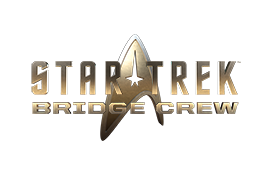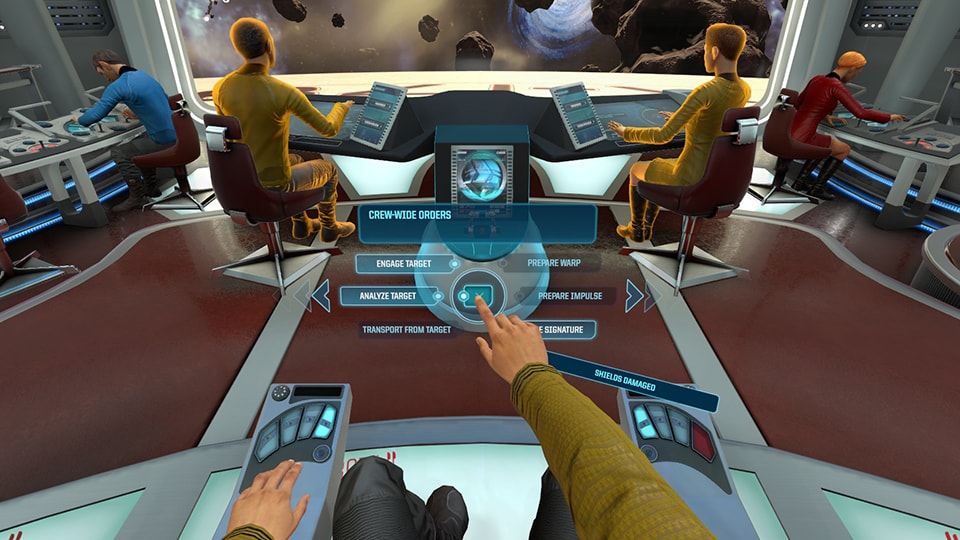When you take the helm (or any of the other officer stations) on a Federation vessel in Star Trek: Bridge Crew, you'll have a willing crew ready to join you in your voyages. And if you don't have enough players to fill out the team, or just feel like exploring space on your own, the crew roles will be filled by AI crewbots who – with the help of Watson-powered voice recognition – will listen to and carry out your commands. In this article, we'll delve into how these crewbots work, and detail how the development team designed them to better support you in your adventures.
The AI crewbots were developed to help fill any roles not occupied by human players, and the game is playable and beatable with an AI crew. However, they may not be as versatile or as capable as your buddies would; given the demands of VR, designing a highly sophisticated AI capable of mimicking a human player would have been too resource-intensive. The team prioritized performance in order to keep framerates high, which is crucial to avoiding player discomfort in VR. With that in mind, the crewbots are a very effective solution, providing basic crew substitutes without any negative impact on framerates.

To interact with your AI crew members, you can either issue commands to them directly using a contextual UI menu, or you can issue crew-wide orders from the Captain's chair. Crew-wide orders are different, in that they can encompass multiple actions undertaken by multiple crew members in concert with each other, as opposed to giving a single order to one crew member.
Crew-wide Orders
Crew-wide orders were developed to help reduce menu complexity, and simplify some complex-but-common behaviors. These commands will work with any combination of players and AI, and are relayed only to the AI crewmembers.
"Analyze Target," for example, will cause Tactical to try to scan once in range, Engineer to set full power to engines, and Helm to fly to the target. You could do this without the crew-wide order, but you would have to drill down into each station's command list in order to do so, and you would have to wait until you're in range to issue the scan order to Tactical. Players execute this sequence of events commonly enough in the game to warrant a quick "macro" for the behavior. "Transport Target" works in a similar fashion: assuming a target has been scanned, Helm will fly to it, Tactical will lower shields if they are up, and Engineer will begin the lock-on process.
Crew-wide orders can be fairly nuanced. For example, the "Cloak Hunt" order (only available on the USS Enterprise NCC-1701-D) will send crew to scanners, adjust power for phasers and shields, arm torpedoes, switch them to trigger on proximity, and steer the ship toward the radar blip. Once "close," the Tactical crewbot will fire. However, the "Engage Target" order will respect the ship's current torpedo-armed state. So if the captain had previously ordered "arm torpedoes" through Tactical's order panel or via red alert, "Engage Target" will fire torpedoes. If they are not armed, the order will not arm them, and the crew will only shoot phasers.
Think of crew-wide orders as a large collection of tiny individual commands whose result is chasing an enemy, hunting a cloaked ship, etc. There are many things going on in the background during one of these orders, and understanding the different layers of commands can help you be a more proficient captain. With that in mind, let's take a deeper look at the Engineer's repairs.

When a mission starts, the Engineer crewbot is initialized with an "auto repair" behavior. This is the most basic default repair mode, and it has a few different outcomes depending on which ship you're commanding. On the Aegis/classic Enterprise bridges, the crewbot will unassign repair crews if the ship has 100% health across all subsystems. If the ship has subsystem damage, auto repair waits until they've sustained 40% damage before acting. This means no crews will be assigned to repairs until these points are reached.
Auto repair works with a priority list (which can be overridden by players) that tells it which subsystem to fix first. Once a subsystem is repaired, it will refer back to the list and reassign crew to other subsystems that are below the damage threshold.
If the captain orders a "Balanced Repair," the 40% limitation is removed and the crewbot will act, based on the priority list, if any system has less than 100% health. The captain can also order repairs to specific subsystems, and the crewbot will repair them until they're back at 100%. Also, if a player modifies and repair crews, the crewbot will leave them alone until their subsystems are 100% healthy. Once all subsystems are healthy, the AI returns to its default auto repair behavior.
Repair works differently for the Enterprise-D. Leaving crew at a subsystem will give a perk if it's healthy, so the Operations crewbot behavior will leave crew at a station if assigned by a player. Additionally, the "Optimize" orders are essentially presets. This helps ensure if the captain orders a preset, the crewbot will not reassign crew designated for the preset for repair duty. Typically, preset orders will leave one floating NPC crewmember to deal with subsystem repairs that are outside the desired optimizations. If a player assigns crew at all, the crewbot will not automatically move crew around on the Enterprise-D. Instead, the captain will have to assign a preset to clear any previous player's settings.
Watson-powered voice recognition
Late in the development cycle (after the crewbots were developed, in fact), the developers were able to work with IBM to utilize Watson, IBM's voice-recognizing, question-answering AI, to make all of this better. What Watson brings to the table is an easier, more intuitive way to operate the crewbot system: voice-driven commands in place of UI menus.
Here's a diagram of how it works:

With Watson, crewbots execute the same orders as when run with the UI. So if for any reason Watson is not available, the crewbots can still be commanded with the UI; this also means you can see what voice commands are possible by checking the UI. The first big advantage Watson brings to the table is a quicker, more intuitive way to issue those commands.
Another advantage is that Watson is able to interpret what you're asking for, even if you don't give an order the "right" way. This means "make it so" and "punch it" and "engage" and many other variations will result in the same command being executed. The developers have enhanced this by "training" Watson with Star trek terminology, so it has a better idea of what to expect and how to interpret what players say.
All of this technology ensures that players can get as close to a full, seamless, responsive Star Trek: Bridge Crew experience as possible, even without a full complement of players. Star Trek: Bridge Crew is available now for PC and PS4, and is playable with or without VR.


